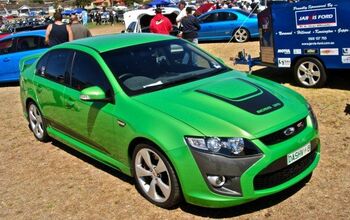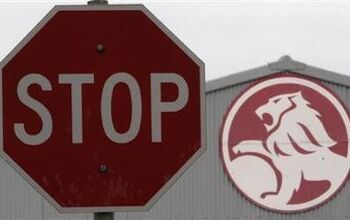"On The Beach;" Is Ford and GM's Future in Australia?

Picture this: Toyota outsells GM and Ford combined. Chrysler is long gone, having sold their factories to a foreign automaker. Meanwhile, GM and Ford import all their products from low-wage countries except for large sedans, whose drooping sales figures are propped-up by fleet sales. Imports fill the top eight spots for retail sales. In the face of massive imports and a strong currency, the Big 3 (Toyota, GM, Ford) informs the feds that they’re considering ceasing all remaining domestic automobile production. Welcome to the Down Under (and out) car market of Australia.
American car enthusiasts tend to envision Australia as an American mini-me holdover from the good old days, when traditional RWD sedans with big straight-six and honking V8 engines dominated the roads and the sales charts. In that rose-tinted rearwards-gazing scenario, the Australian divisions of Detroit’s Big 3 carve-up big chunks of the market for themselves, stake claims on the best selling cars, and generate handsome profits for mother Detroit.
In reality, Australia’s domestic car industry is hanging on by a thread. In fact, the antipodean market offers a scary glimpse into the possible future of the American automobile industry.
Back in the day, Chrysler of Australia created some legendary machines with hemi six cylinder engines that Ford and GM’s V8s couldn’t catch. Ultimately, it was to no avail. In case you missed it (or you’re younger than thirty), Chrysler called it quits Down Under in 1980. Twenty-eight years after Chrysler handed the keys to their plant to Mitsubishi, they’ve announced its closure.
Analysts who think GM and Ford will get a boost if/when Chrysler goes bust in the US should consider the Australian example. Since Chrysler withdrew, GM's Holden and Ford-AU’s market share has fallen even more precipitously than their American parents'. Holden now accounts for about 15 percent of Australia's new car market. Ford is precariously close to single digits. Toyota dominates, with a commanding 25 percent market share and most of the top-selling cars and trucks.
And yet, Holden and Ford still claim bragging rights to the number one (Commodore) and number two (Falcon) selling cars in the land of Oz. Pay no attention to those men behind the curtain. In another eerie equivalent to stateside PR, their claims are based on smoke, mirrors and fleet sales.
In Australia, the major manufacturers have agreed among themselves to not reveal fleet sales. They believe (rightly) that the numbers would damage public perception of the home-town teams. The Sydney Morning Herald managed to get their hands on a set of stats– and no wonder they’re secret. No less than 81 percent of the Commodore’s sales and 88 percent of Falcon’s sales sailed with the fleets.
Amongst buyers paying with their own money, the Commodore was merely number nine; the Falcon a distant fifteen. Not surprisingly, the Corolla is tops with private buyers, followed by the Mazda 3 and the Toyota Yaris. Holden’s best seller (to the public) is the Korean-built Barina (a.k.a. Chevrolet Aveo).
It turns out that Australia isn’t a parallel universe, immune to oil prices and environmental trends. The market for large cars declined 37 percent in 2005 and 2006; and it’s still contracting. The Toyota Camry is the only locally-made four-cylinder large car. The Aussie Big Two never developed smaller cars, and didn’t build a single four cylinder car for… just about forever. Ford has only just started building the Focus locally.
Ford’s restyled Falcon has just been revealed, but it’s riding on a tired old platform that wouldn’t cut it beyond its loyal but rapidly shrinking fan base (think Crown Vic). Thankfully, Ford has just announced the final solution to the geriatric twosome: a clean-sheet next-generation RWD platform to be developed in Australia.
By the same token, Holden has become GM’s RWD “home room.” It’s vying for development of the small RWD Alpha platform. But exports of Aussie RWD vehicles are not viable (G8 excepted). In fact, Ford may import the next-gen RWD cars or stampings from the U.S. These development projects don’t guarantee a future domestic production industry.
Bottom line: GM and Ford’s Australian units are sinking fast. Holden reported a $145m loss in '06, and $146m in '07. Ford-AU nicked mother Dearborn’s pocketbook a bit more gently, with a loss of merely $40m. No wonder GM and Ford are throwing development dollars for rear wheel-drive (RWD) cars to the Aussies. Without the imported bucks, they might soon be toast.
Meanwhile, the Australian reports that senior auto executives are warning that “union trouble or higher wages would be a poison arrow” for local car manufacturing. And Toyota is “reviewing” local Camry production. At the same time, China has targeted Australia for future automotive exports.
Welcome to the future.

More by Paul Niedermeyer
Latest Car Reviews
Read moreLatest Product Reviews
Read moreRecent Comments
- Honda1 Unions were needed back in the early days, not needed know. There are plenty of rules and regulations and government agencies that keep companies in line. It's just a money grad and nothing more. Fain is a punk!
- 1995 SC If the necessary number of employees vote to unionize then yes, they should be unionized. That's how it works.
- Sobhuza Trooper That Dave Thomas fella sounds like the kind of twit who is oh-so-quick to tell us how easy and fun the bus is for any and all of your personal transportation needs. The time to get to and from the bus stop is never a concern. The time waiting for the bus is never a concern. The time waiting for a connection (if there is one) is never a concern. The weather is never a concern. Whatever you might be carrying or intend to purchase is never a concern. Nope, Boo Cars! Yeah Buses! Buses rule!Needless to say, these twits don't actual take the damn bus.
- MaintenanceCosts Nobody here seems to acknowledge that there are multiple use cases for cars.Some people spend all their time driving all over the country and need every mile and minute of time savings. ICE cars are better for them right now.Some people only drive locally and fly when they travel. For them, there's probably a range number that works, and they don't really need more. For the uses for which we use our EV, that would be around 150 miles. The other thing about a low range requirement is it can make 120V charging viable. If you don't drive more than an average of about 40 miles/day, you can probably get enough electrons through a wall outlet. We spent over two years charging our Bolt only through 120V, while our house was getting rebuilt, and never had an issue.Those are extremes. There are all sorts of use cases in between, which probably represent the majority of drivers. For some users, what's needed is more range. But I think for most users, what's needed is better charging. Retrofit apartment garages like Tim's with 240V outlets at every spot. Install more L3 chargers in supermarket parking lots and alongside gas stations. Make chargers that work like Tesla Superchargers as ubiquitous as gas stations, and EV charging will not be an issue for most users.
- MaintenanceCosts I don't have an opinion on whether any one plant unionizing is the right answer, but the employees sure need to have the right to organize. Unions or the credible threat of unionization are the only thing, history has proven, that can keep employers honest. Without it, we've seen over and over, the employers have complete power over the workers and feel free to exploit the workers however they see fit. (And don't tell me "oh, the workers can just leave" - in an oligopolistic industry, working conditions quickly converge, and there's not another employer right around the corner.)































Comments
Join the conversation
Anyone every heard of a Japanese or Korean union striking?
The South Korean auto unions are fairly militant, from what I've read, and will not hesitate to go out on strike.